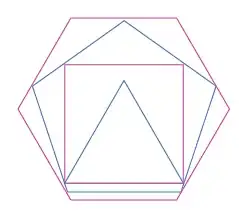I want to build a figure that contains seven regular polygons, from a triangle up to a nonagon, where each n-sided polygon covers, with the minimal area possible, the n-1 sided one. An added restriction is that each of them should have a horizontal base.
With this figure constructed, I'd like to study its properties (mainly the side and area of each polygon, ideally expressed as a function of the triangle's side).
I wonder if there's a way to build this, either with a rule and a compass (unlikely, I presume) or by using a dedicated software program for this effect.
Thanks.

